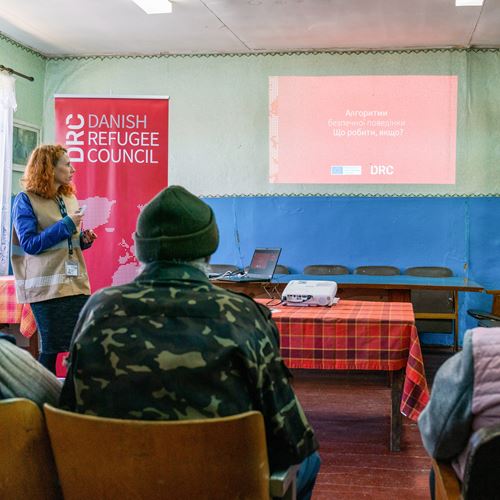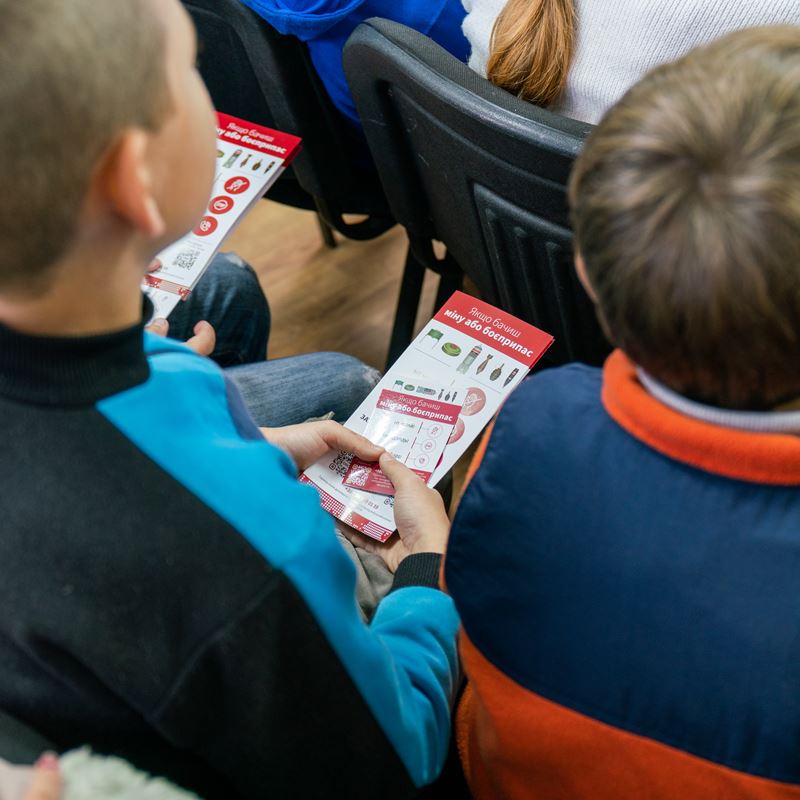EORE online courses are available in Ukrainian via links:
If you want to attend the online sessions conducted by DRC specialists, please, register here.
From village to village, from town to town — DRC’s Explosive Ordnance Risk Education (EORE) teams travel across Ukraine to spread the knowledge of safe behaviour around Explosive Remnants of War. Fighting has contaminated vast parts of Ukraine’s territory including residential areas, roads, agricultural land, forests, lakes and rivers – leaving invisible threats hidden in places which were previously safe for decades.

Widespread digital risk education campaigns have already reached over 170,000 people in Ukraine since 24 February 2022. In addition, DRC EORE teams in Ukraine have conducted more than 120 direct sessions on location teaching the ways of safe behaviour to almost 2,400 people in-person. These activities help create awareness not least among people who may otherwise not pay attention to the information campaigns on social media. Moreover, the two-way communication and discussions are more comprehensive and give the audience an opportunity to ask about specific details that are important to them.
With funding from the European Union, DRC plans to provide additional direct sessions in five oblasts in the north and east of Ukraine over the winter. In Ivankivska community in Kyiv Oblast, DRC uses an integrated approach with risk education activities together with the surveying of contaminated areas prior to launching the actual demining operations.
“Currently in this community, risk education activities go hand-in-hand with surveys. When our survey teams finish their search for explosive ordnance, we understand where the contamination is and in which villages, we need to prioritise risk education sessions,” says Ksenia, DRC EORE Facilitator.
Zaruddia village, 80 kilometres from Kyiv city, where over 200 people live, is one such settlement. After active fighting there in spring, the territory of this village is heavily contaminated with explosive remnants of war.
"Signs about mine dangers are red – the colour of danger and like blood. For greater visualisation, it also has bones painted on it. This way, it is clear exactly what can await you if you enter this area,” explains Ksenia during the session.
After a risk education session in Zaruddia, a participant added: “My house was hit with a missile and a lot of its parts are still around. I am very anxious about this situation but now I at least better understand risks and how different ammunition works - and what I should do in case I find any”.
Olyva, a village of 400 inhabitants, is located nearby. Oksana, a representative of the local authorities, tells about having actually seen some of the mines that were depicted in the DRC risk education materials. Fortunately, her findings were soon after removed and demolished by the State Emergency Service of Ukraine.
“Active hostilities took place here. The village was shelled, and such sessions are useful for people because they find a lot of explosive remnants of war. There are still areas where a lot of ammunition lies. These are marked with signs and red tape, and we were warned not to go there,” Oksana adds.
A school in Olyva village is the only education facility in the district that has not seen serious damage. Here, DRC conducted several risk education sessions for children. DRC specialists try to engage children of all ages, using simple vocabulary, cartoons, and gamification.
The school principal, Olena, tells how such sessions are extremely important to reduce the risk of explosives causing deaths and injuries among civilians. Olena tells that a couple of months ago, a family hit an anti-vehicle mine on a road from Olyva to another village. The mother died together with her baby. Another accident happened with a farmer who tried to cultivate his land. Luckily, he survived.
“Thanks to these regular risk education sessions, the villagers are more aware of the danger they may face around their neighbourhood and how to minimise the risks,” Olena says.

Kyiv Oblast, October 2022, Oleksandr Usik ©DRC Ukraine
If you want to attend the online sessions conducted by DRC specialists, please, register here.